Physical Address
304 North Cardinal St.
Dorchester Center, MA 02124
Physical Address
304 North Cardinal St.
Dorchester Center, MA 02124
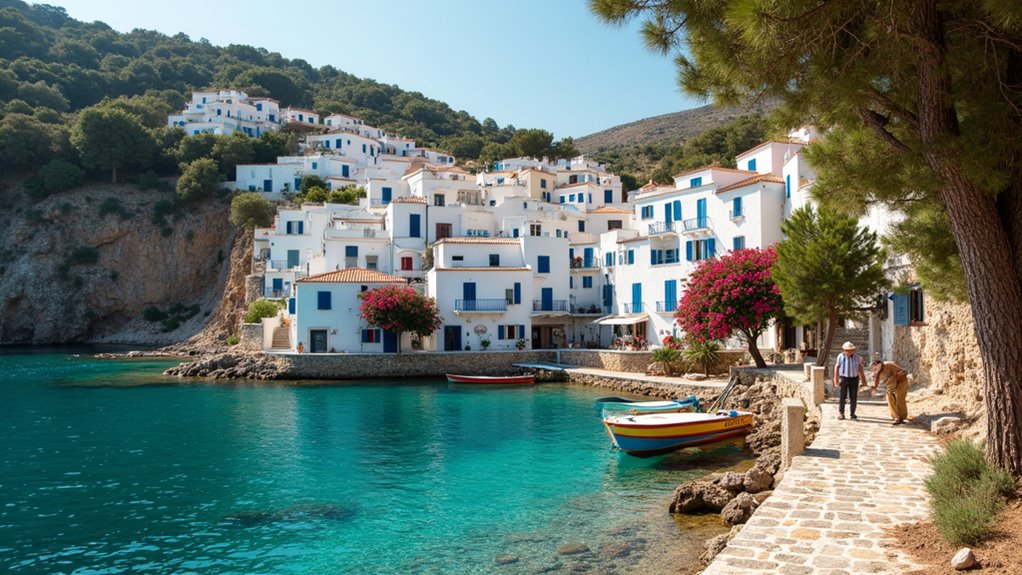
Hesitating between Paxos and Corfu? Discover which Ionian island matches your Greek dream vacation.
Just as you’ve been deliberating between these two Ionian gems, I found myself making the same choice last summer. Paxos offers that untouched Greek island experience you’ve imagined—olive groves, turquoise coves, and village squares where time seems to stand still. Corfu, meanwhile, balances its Venetian heritage with buzzing cafés and diverse beaches. Your decision ultimately hinges on whether you’re seeking peaceful seclusion or vibrant culture. The contrasts between these neighboring islands reveal two entirely different Greek experiences.
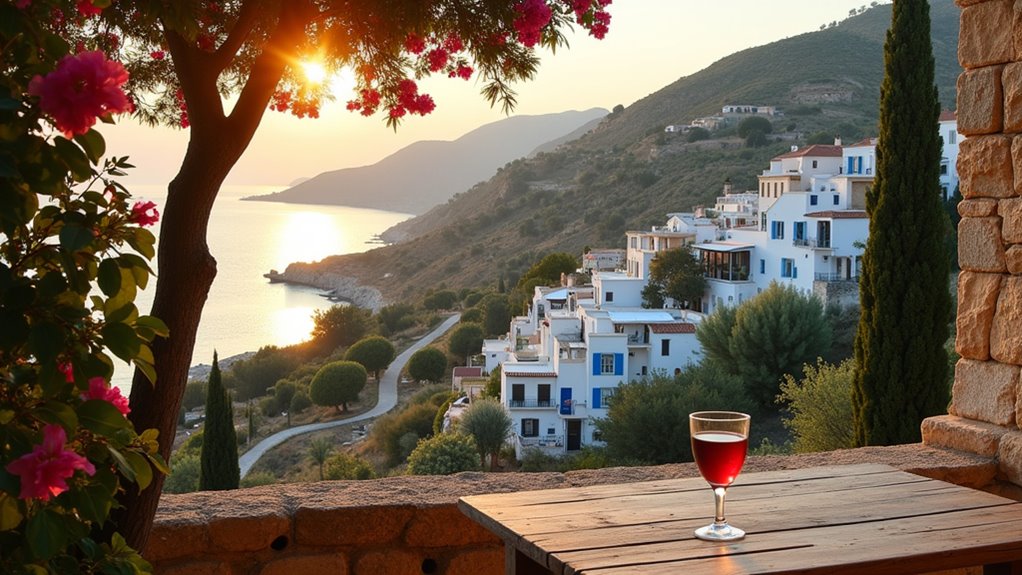
When exploring the Ionian Islands, you’ll find distinct geographic personalities that shape your experience. Paxos offers a compact 25 sq km layout with chiefly flat terrain—ideal for easy exploration on foot or by scooter. Its highest point, Agios Isavros, reaches just 231 meters, while a single main road runs along the island’s spine.
In contrast, Corfu presents a more diverse landscape with mountains, hills, and plains. Mount Pantokrator dominates the skyline, and the island’s larger size accommodates more developed infrastructure. According to local mythology, Paxos was created when Poseidon cut off part of Corfu with his trident’s anchor.
Both islands feature stunning coastlines, but Paxos’s eastern shores house most of its beaches, while its western side reveals dramatic sea caves. Budget travelers will appreciate Paxos’s walkable size, though Corfu offers more varied terrain to explore. Families seeking holiday destinations often choose Corfu for its family-friendly spots that combine natural beauty with entertainment options for children.
After exploring the distinctive landscapes of these Ionian gems, you’ll need to figure out how to reach and navigate them. Corfu offers more accessibility options with its international airport and extensive ferry connections. Unlike Corfu, Athens’ rich heritage makes it a fascinating detour before heading to the islands.
Reaching Paxos requires a ferry from Igoumenitsa, taking 1.5-2 hours.
Once on the islands, transportation differs dramatically. Paxos maintains a simpler system with limited public buses (€1.80-€3), just five taxis (book ahead!), and sea taxis for island-hopping to Antipaxos. The local bus follows a circular route pattern, connecting the main villages of Lakka, Loggos, and Gaios with four daily departures during summer months.
Corfu boasts a more inclusive network of buses, taxis, and rental options.
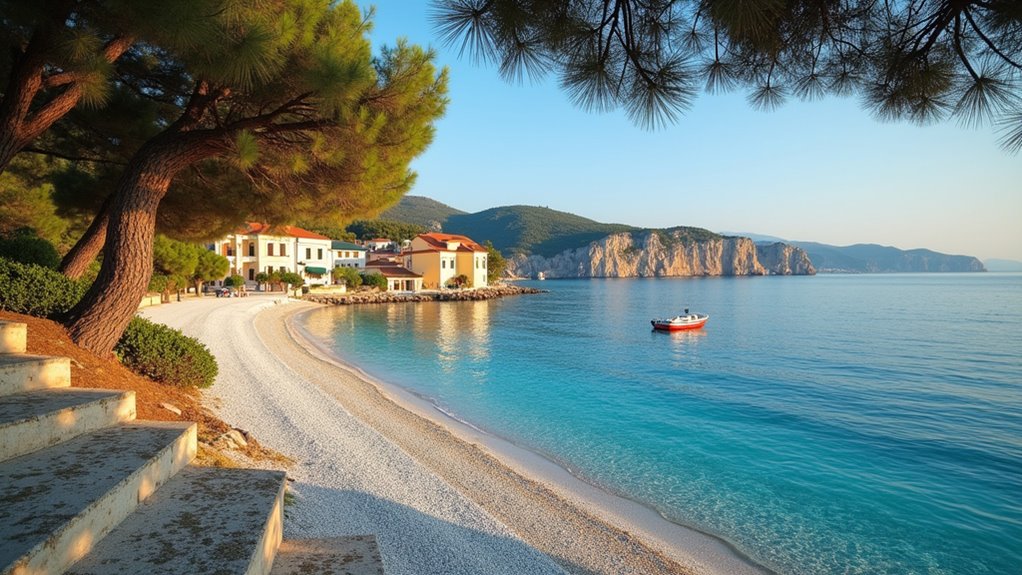
The crystal-clear waters surrounding both Paxos and Corfu offer distinctly different seaside experiences, though each island delivers its own version of Ionian magic. Paxos shines with secluded coves like Erimitis Bay and exceptional snorkeling visibility (up to 30m) thanks to its white pebble seabeds. The trade-off? Fewer amenities outside main towns. Orkos Beach, with its clear, lovely water, makes it particularly ideal for swimming and snorkeling enthusiasts.
Corfu balances accessibility with variety – from Paleokastritsa’s six rocky coves to Glyfada’s golden sands. You’ll find more facilities but encounter peak-season crowds, especially July-August. The island offers perfect spots to enjoy a Greek breakfast overlooking the azure waters before starting your day of exploration.
For the best swimming conditions, visit Paxos in September (24-25°C water, minimal crowds). In Corfu, consider October for mild swims (22°C), though some services reduce. Remember: Paxos beaches often require your own gear and shade provisions.
Despite their proximity in the Ionian Sea, Paxos and Corfu offer remarkably different cultural landscapes for history enthusiasts. While Corfu isn’t covered in our guide, Paxos delivers an authentic culture through its Venetian military heritage and religious sites. Unlike larger Greek islands, Paxos offers a more intimate setting to explore historical landmarks without the crowds.
Most heritage sites are accessible year-round, though monastery visits are best planned during summer months when access restrictions are minimal. History enthusiasts should make time to see the Ruins of Early Christian Basilica of Agia Marina near Ozias Beach, which dates back approximately 1,600 years old to the 6th century.
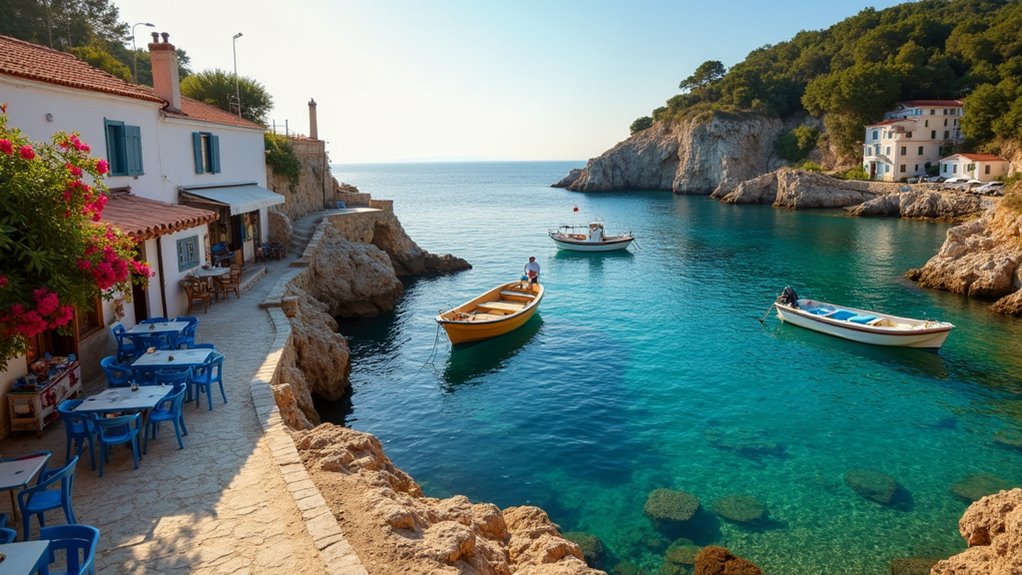
When considering the Ionian islands for your summer escape, understanding crowd patterns between Paxos and Corfu can dramatically impact your experience.
Paxos concentrates 2 million annual visitors across just 25 km², creating intense summer crowds despite its upmarket atmosphere and serene beaches outside midday hours. Unlike many Greek islands, Paxos remains remarkably green year-round due to its abundant olive groves and unique weather patterns.
Corfu, being substantially larger, absorbs its travelers across multiple hotspots like Paleokastritsa and Sidari, with family-oriented resorts dominating most areas. The Kavos region becomes backpacker party central June-September. Unlike the popular Rhodes and Mykonos which attract celebrity visitors year-round, Corfu maintains a more traditional Greek atmosphere.
For breathing room, target May or September when Paxos sees 30-50% fewer visitors with pleasant 24°C temperatures.
Corfu offers cultural alternatives like October’s Wine Festival when crowds thin.
Remember that Paxos lacks an airport, requiring a €24 hydrofoil from Corfu, while Corfu’s superior infrastructure includes year-round flights from 30+ European cities.
Finding your ideal accommodation in both Paxos and Corfu requires understanding each island’s distinct character and layout. Paxos offers four main areas: Gaios (the capital with extensive amenities), Lakka (charming harbor), Loggos (beach access), and Ozias (tranquility). Self-catering options dominate Paxos, giving you flexibility and local immersion. The island offers a range of accommodation types from luxury boutique hotels to traditional stone houses and budget options to suit various preferences. While Corfu tends to have higher price points for accommodations compared to many Greek destinations, it still offers value for the experience.
Corfu features more diverse districts, from the historic Old Town to beach-centric Sidari and Benitses, giving you more variety based on your specific interests.
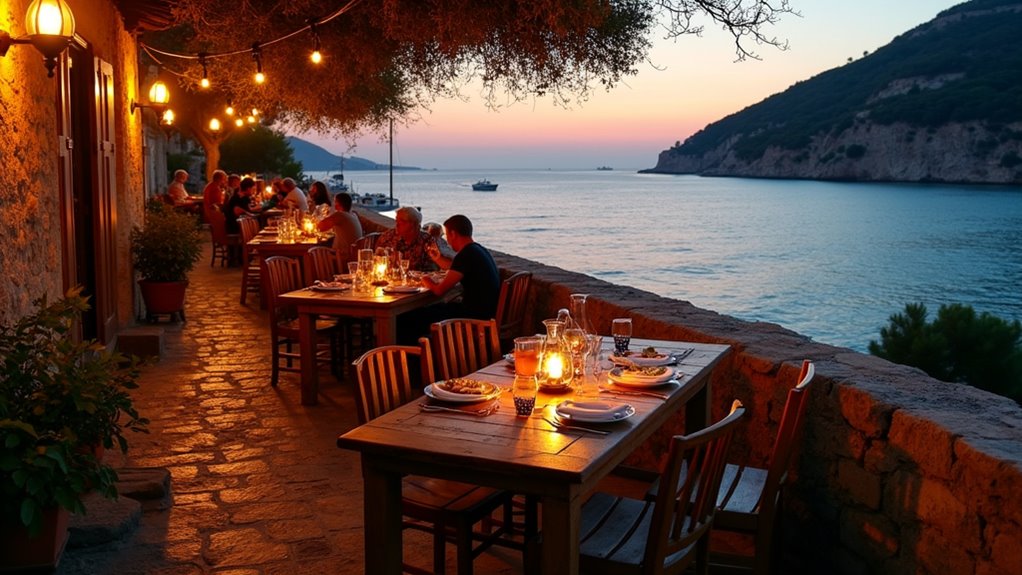
The culinary experiences on Paxos and Corfu reveal as much about their contrasting personalities as their landscapes do. On Paxos, you’ll dine in intimate settings where Mediterranean cuisine showcases fresh seafood and local produce. Expect homemade pastas reflecting Greek-Italian fusion at family-run tavernas. Paxos boasts a vibrant food scene where even the simplest meals are prepared with care, making it nearly impossible to have a poor dining experience.
Corfu’s dining scene offers similar Greek staples but with stronger Italian influences—a nod to its Venetian history. You’ll find that both islands offer exceptional value with budget-friendly options available alongside more upscale establishments.
For nightlife, the difference is stark. Paxos keeps it low-key with waterfront bars and the occasional live music at venues like Carnayo Gold Lounge, with just one nightclub in Gaios.
Meanwhile, Corfu pulses with energy after dark. Beach bars, cocktail lounges, and clubs in Corfu Town provide options from relaxed to rowdy—perfect if you’re seeking more vibrant evening entertainment.
Beyond the dining and evening entertainment, both islands serve as excellent bases for exploring the surrounding Ionian treasures. Paxos offers intimate boat cruises to Antipaxos and the stunning Blue Caves, while Corfu’s larger size supports diverse day trips from beach-hopping to mountain monastery visits at Meteora. Greek ferry services connect these islands to numerous other destinations throughout the Aegean and Ionian seas.
The Ionian’s twin gateways invite exploration beyond their shores, each offering distinct adventures from intimate coves to mountaintop sanctuaries.
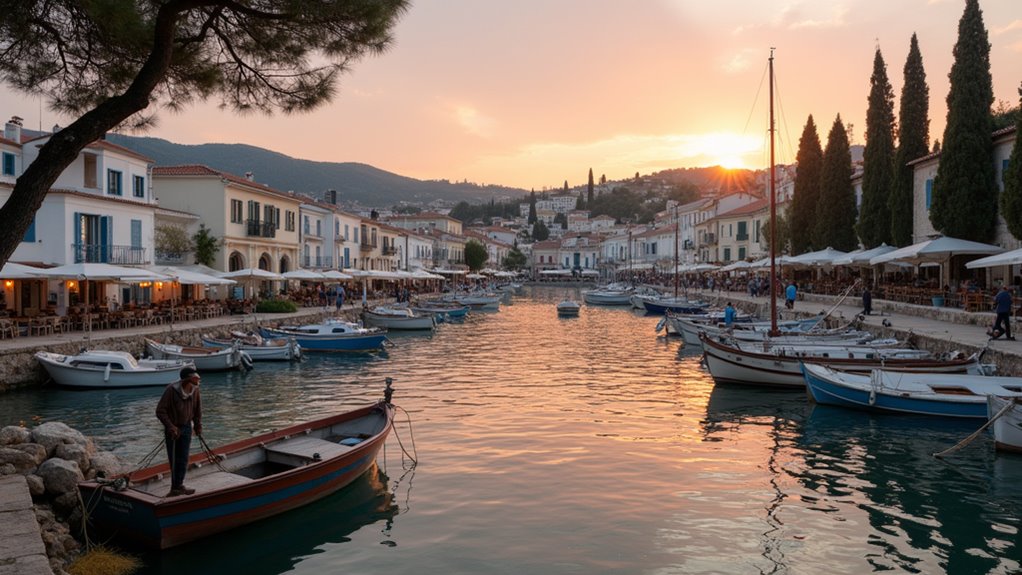
While both islands are nestled in the Ionian Sea, Paxos and Corfu offer dramatically different lifestyle experiences that’ll shape your Greek getaway.
On Paxos, you’ll embrace a village-centered rhythm where olive groves and rocky coastlines create a secluded retreat. The 25-minute cross-island drive highlights its intimate scale, with minimal commercialization preserving its traditional identity. With just 2,300 residents, Paxos offers an authentic glimpse into quiet Greek island living rarely found in more developed destinations.
You’ll find yourself among nature enthusiasts seeking tranquility over nightlife.
Corfu pulses with more energy through its UNESCO Old Town, varied beaches, and blend of Venetian, French, and British influences. Unlike the volcanic landscapes you might find in Santorini, Corfu offers lush greenery and diverse coastal experiences. Its established infrastructure supports families and cultural travelers year-round thanks to international airport access and extensive public transport.
Your choice boils down to preference: Paxos’s off-the-grid serenity or Corfu’s accessible blend of history, amenities, and natural diversity.
Whether you choose Paxos or Corfu, you’ll get more bang for your buck by visiting in shoulder season. For culture, try local buses over taxis and eat where locals gather rather than tourist spots. Paxos offers tranquility and unspoiled beaches, while Corfu delivers vibrant towns and diverse attractions. Trust your travel instincts—the perfect Greek island experience awaits, whichever path you choose.